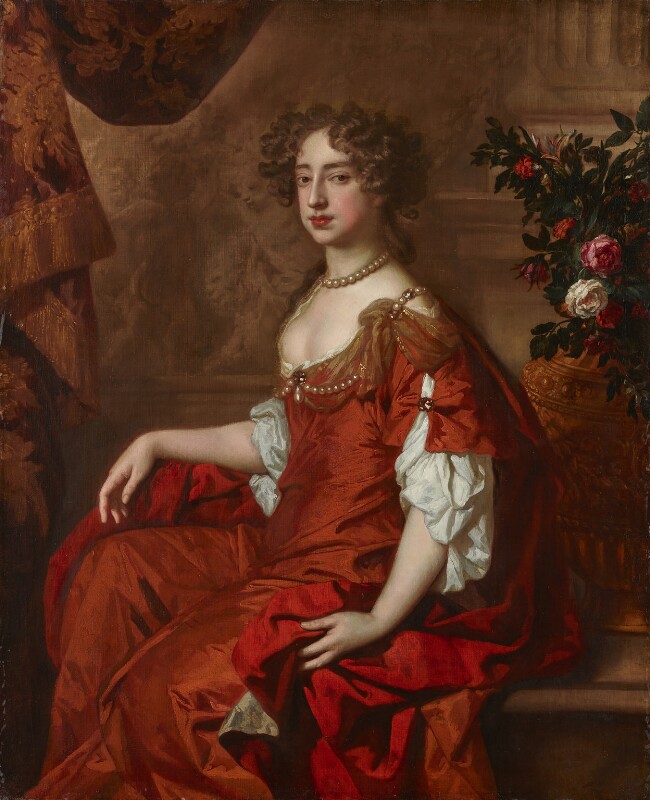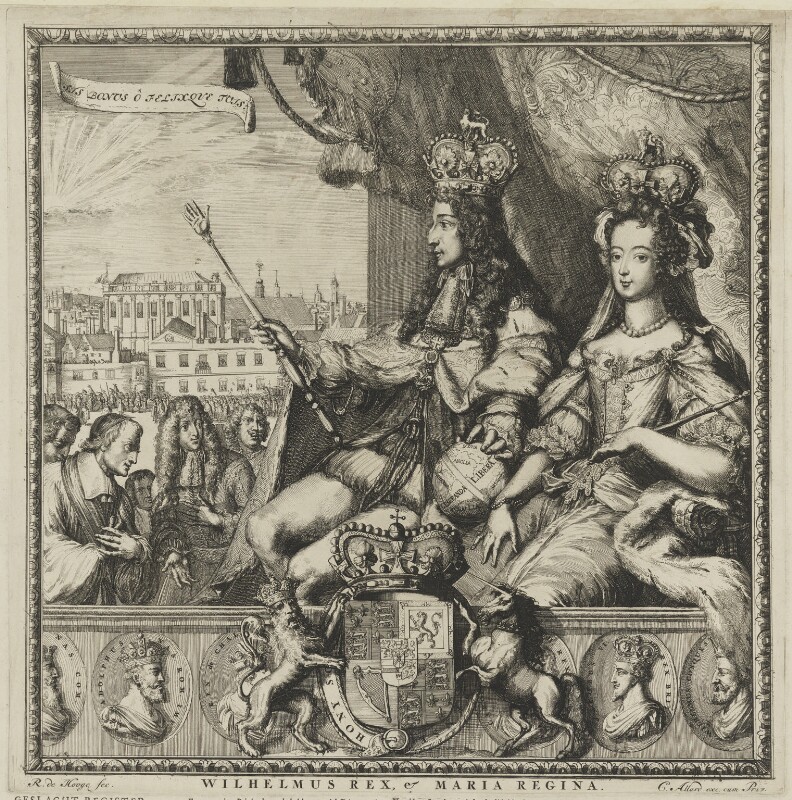A Love Story: King William and Queen Mary
February 14, 2023
By
Mary Miley Theobald ’74, M.A. ’80
Theirs was a love match, but no one would have guessed it from the way it began. William of Orange was Dutch by birth, 27 years old, 5 feet, 6 1/2 inches tall, slightly hunchbacked, with a hooked nose. A childhood bout with smallpox had left him with an asthmatic wheeze and a mottled complexion. On seeing him at Whitehall, one English lady wrote that he was “the plainest man ever seen and of no fashion at all,” referring to his lack of wig and simple clothes (which, to be fair, had been ordered from Paris). He did not like theater or dancing or swearing, had no social graces, felt ill at ease in crowds, avoided women and went to bed by 10 o’clock. Although his mother was English (the sister of King Charles II and King James II), he spoke the language haltingly and despised trivial conversation. Some reports said he was prim, bad-tempered and had no wit. On the plus side, he enjoyed hunting.

Queen Mary II by Sir Peter Lely, oil on canvas, circa 1677
NPG 6214 © National Portrait Gallery, London
Lady Mary was 15 and one of the most eligible young women in Europe. As second in line to the throne after her father, she and her sister Anne lived in the maelstrom of the Protestant-Catholic conflict. A lovely girl with a sense of humor and unspoiled manners — she had been kept far away from the licentious court of her uncle, King Charles II — she towered over William by 4 or 5 inches. She was described by one contemporary as having black hair, a clear, pale complexion, high and open brow, large eyes that protruded slightly, a beautiful throat, a slender and shapely figure and manners full of sweetness and majesty. In view of her age, it seems rather churlish for some to call her childishly romantic, but her preference for romantic novels was well known. Poorly educated in every subject except Protestantism, she nonetheless possessed an innate intelligence that would surprise government ministers in later years and an unaffected charm that would make her popular with her subjects in Holland and England alike.
Moments after these cousins met for the first time, William left her to go directly to her uncle, Charles II, and her father, Prince James (later King James II), to ask for her hand in marriage.
James, a Catholic, was against the marriage of the heir to the throne to a Protestant. His ally, Louis XIV of France, was equally anxious to prevent a Dutch-English alliance. Though young, William of Orange had been the leader of a strong coalition against France and had proven himself fearless in battle. But King Charles approved, and his was the only opinion that really mattered. The horrified French ambassador expressed shock that “the eldest daughter of the Crown should sleep in Protestant arms.” The Sun King wrote James a furious letter, berating him for giving his daughter to his mortal enemy in Holland.
No one bothered to consult the bride. When Mary learned she was to marry this cousin and leave her country for Holland, “she wept all that afternoon and all the following day,” said her chaplain. Her aunt, Queen Catherine of Braganza, tried to console her, reminding Mary that she had left her home in Portugal to come to a foreign country and marry a man she had never even seen, but Mary countered with 15-year-old logic, “Madame, you came into England; I am going out of England.” Undeterred, William wanted the wedding to take place at once so he could return to the Hague to prepare — of all the romantic things — his military budget. King Charles complied.

King William III; Queen Mary II by Romeyn de Hooghe, published by Carel Allard etching with additional letterpress text, 1689 or after
NPG D32270 © National Portrait Gallery, London
The wedding was a hasty ceremony in Mary’s apartments at 9 p.m. on Nov. 4, 1677. The few witnesses must have been miserable. The groom was sullen, the bride in tears. Her father was furious and his brother, the king, cracked tasteless jokes. The newlyweds went to bed at 11 that night, an hour past William’s usual time.
Against all logic, Mary fell deeply and unexpectedly in love with her husband and, later, he with her. She also came to love Holland so much that she could hardly bring herself to return to England as queen in 1689. Mary ruled England with her husband, deferring to him when he was present, but taking up the reins of government quite ably when he was away fighting, which was often. She suffered terribly whenever William fell ill or left to fight the French. “You will forgive me,” she wrote him, “if I forget half what I have to say for really my concern for you has got the mastery, and I am not able to think of anything else, but that I love you in more abundance than my own life.”
In 1693, William and Mary chartered a new college in Virginia to train Anglican priests and convert Native Americans to the Anglican faith, effectively combining Mary’s interests in religion and education. When she died the following year of smallpox at age 32, William was devastated. Although not the best of husbands, he had come to love and value her so much that her death rendered him inconsolable. He never remarried.
Mary Miley Theobald ’74, M.A. ’80 is the author of 15 nonfiction books, 200 magazine articles and eight historical mysteries written under the pseudonym Mary Miley. She taught American history and museum studies at Virginia Commonwealth University for 13 years. She is also the class reporter for the Class of 1974 in the W&M Alumni Magazine.